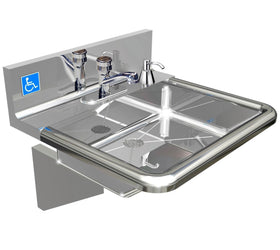HOW TO: Clean, Maintain, and Care for your Stainless Steel Sink
Follow these easy guidelines to make sure your sinks look spotless - always!
One of the many upsides of purchasing a heavy duty stainless steel sink is the ease of keeping the sink looking like new for years to come. As mentioned in the name, the material used to make the sinks is "stainless," meaning that it is almost impossible to get stains on the sink. That being said, there are ways steel can build residue, possibly develop rust or corrode and hoarder bacteria. We have composed this guide to help fight off potential "stains" to your stainless steel sinks.
Periodic Maintenance
To prevent corrosion, rust, and bacteria, it is recommended that there is some form of periodic maintenance and cleaning performed to keep the stainless. Aside from eliminating the possibility of rust or corrosion, this will ensure the sinks look shiny and new.
Best Sheet Metal recommends rinsing the sink after every use, cleaning the sink every week with a mild detergent, and maintenance cleaning every 6 months with a 3M Scotch Brite Pad.
- Daily rinsing: It is highly recommended the stainless steel sink is rinsed after every use. Many soaps and detergents used contain chlorides which cause corrosion in stainless steel. Chlorine in contact with water and as a dissolved gas, sometimes found in water treatment applications, is potentially aggressive to stainless steels. Condensates formed over chlorinated water in storage tanks have been known to result in staining or pitting to stainless steels. A simple rinse after every use can help combat the threat of corrosion.
(Read more about the forms of Corrosion to stainless steels Here)
In addition to rinsing after every use, we recommend wiping down the sink to completely dry it. Remember to always rub in the direction of the polish lines so that your efforts blend with the surface of your sink. Cleaners such as Bon-Ami, Bar Keepers Friend or other typical household cleaners are recommended. These cleaners can easily be used with warm water, sponges or clean cloths.
- Weekly Cleaning: To ensure there is no corrosion or rust, it is recommended the sink be well cleaned weekly. We recommend using a light cleaner and soft abrasive - such as a soft towel to buff lightly. This is a preventative measure. When cleaning, always go with the grain of the steel to ensure there are no scratches or marks left behind.
- 6 Month Maintenance: We recommend a maintenance be done to the sink every 6 months to ensure absolutely no stains. If you see a difficult spot that has not come out, even with the weekly cleanings, use 3M Scotch Brite pad to buff them out. Always rub with the grain of the stainless. After you have buffed, use a 100% cotton cloth to clean the Stainless Steel. Rinse thoroughly with water after rubbing out the spot. Remember to fully dry the sink after cleaning.
Tips:
- Try to keep your sink dry as much as possible. After every light cleaning, dry your sinks with a soft cloth to ensure there is no ongoing bacteria build up or corrosion caused by chlorides.
- Do not leave any soap cleaners, towels or sponges air dry on the sink as they can damage the surface below them.
- Make sure all the solvents or detergents used to clean your sink are free from added chlorides.
- Save your hands! when cleaning your sink, we highly recommend using gloves.
- Never mix cleaners. A reaction caused by mixing cleaners can be dangerous. Try to stick to the same cleaners.
- Never use abrasive cleaners, chemicals, steel wool, or copper wool pads on stainless steel surfaces.
- Never use chlorine based cleaners or iron wool pads to clean the surfaces as they may scratch, mar, or contaminate the material. Only use stainless steel products on stainless steel surfaces.
-
Never use cloths or towels that may have grease on them or have residue. For best results use 100% cotton cloths. Here is our favorite: Freedom Stainless Steel Cleaning Cloth
- Any rubber mats or wet sponges can damage your sink as they trap water and promote discoloration. We recommend they be stored away from your sink while not in use.
- Avoid leaving any other cookware such as metal pots and pans, cast iron pot or pans for an extended amount of time as they can rust and stain your sink.
- Do not use your sink as a cutting board. Drain Boards are intended to have items put temporarily on them to dry. As the surface has a small incline, there is a great possibility item can slip. An injury may occur when if the board is used for cutting.
Shiny Sinks
- Baking Soda: Use baking soda as a light cleaner. Try making a paste from the baking soda by adding a bit of water. Apply it to your sink gently and rubbing with a 100% cotton towel. After you have rubbed the paste all over the sink, rinse with vinegar. This will naturally disinfect the sink while removing any water stains on your sink.
- Club Soda: For a quick clean, use club soda. Simply rinse your sink with club soda and rub with a soft cloth. Once done, completely dry the entire surface of the sink.
- Olive oil: To seal the shine after cleaning your sink, rub a couple drops of olive oil onto a lint-free cloth and buff. This will add an extra sparkle to your sink.
Please see downloadable instructions below.
Maintaining and caring for your stainless steel sinks help keep them in great shape for years to come! If you have any specific questions on care for your sink, feel free to contact us at (888) 444-0773 or send us an email at Bestsheetmetalinc@bsmss.com.



Comments
Leave a comment